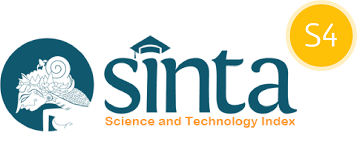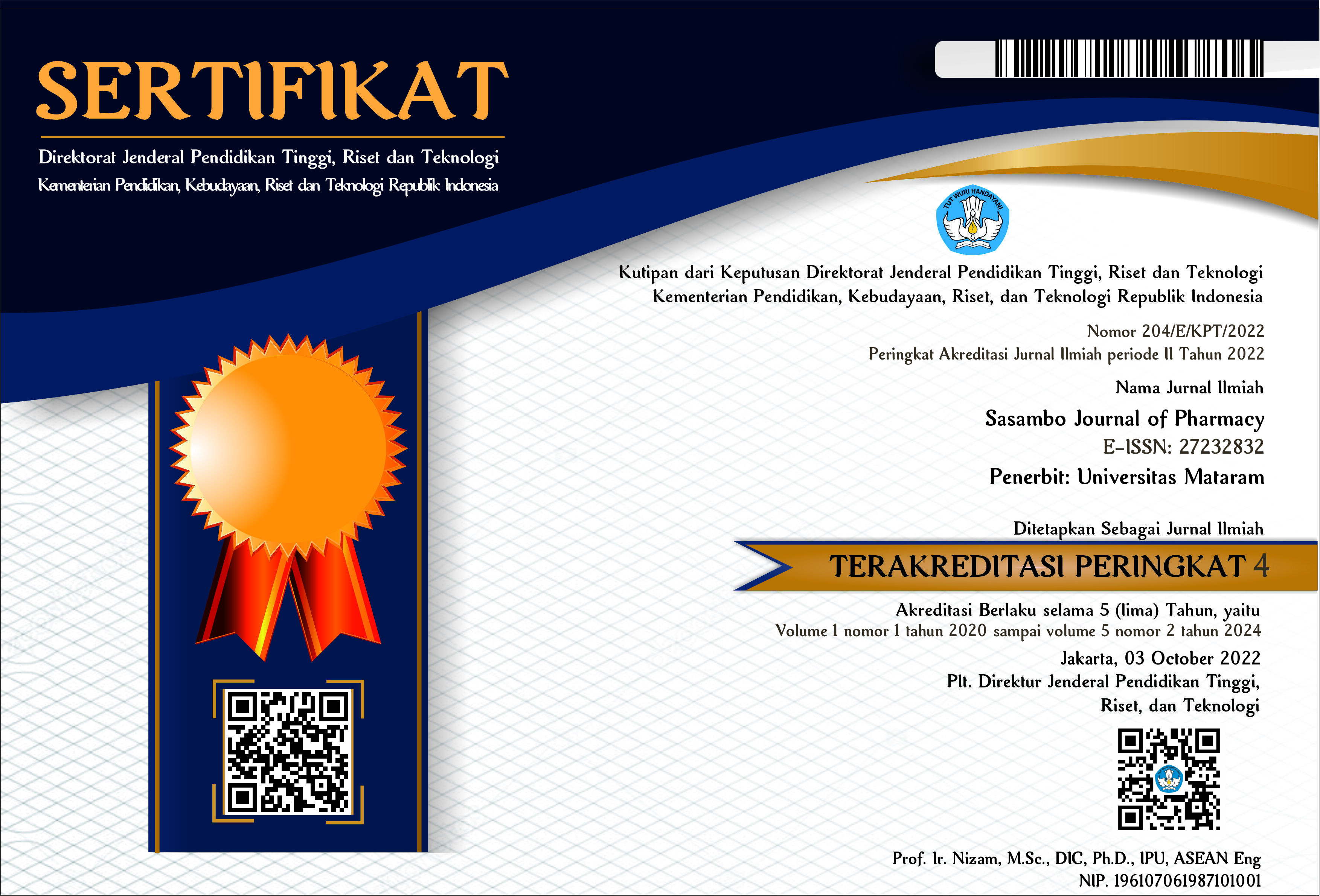Evaluasi pola penggunaan obat dispepsia berdasarkan indikator WHO (World Health Organization) pada pasien rawat jalan Puskesmas Karang Taliwang tahun 2019
DOI:
10.29303/sjp.v3i1.139Downloads
Abstract
Dyspepsia is a collection of several clinical symptoms consisting of pain in the pit of the stomach, flatulence, early satiety, nausea, and vomiting. The incidence of dyspepsia at the Karang Taliwang Public Health Center until 2019 was quite high. Evaluation of drug use at the Puskesmas has never been carried out, so it is necessary to know the pattern of use of dyspepsia drugs at the Karang Taliwang Public Health Center. This review aimed to determine the pattern of dyspepsia drug use in outpatient dyspepsia at Karang Taliwang Public Health Center using prescribing indicators developed by the World Health Organization. This study is a descriptive study of retrospective drug use. Sampling using a consecutive sampling method. Prescription data and medical records were collected through observation sheets. The results of the study on drug use patterns were the average number of drug items per sheet of 2.55 prescription; the percentage of drugs prescribed with generic names was 99,37%; the percentage of prescription drugs with antibiotics was 1.61%; the percentage of prescription drugs with injection preparations was 0%; and the percentage of drugs prescribed according to the Formularium was 96.84%.
Keywords:
dyspepsia, drug use patterns, suitability of drug useReferences
Arsyad, R.P., Irmaini, I., & Hidayaturrami, H. (2018). Hubungan sindroma dispepsia dengan prestasi belajar pada siswa kelas XI SMAN 4 Banda Aceh. Jurnal Ilmiah Mahasiswa Kedokteran Biomedis, 3(1), 36-42. http://www.jim.unsyiah.ac.id/FKB/article/view/6757
Desalegn, A.A. (2013). Assessment of drug use pattern using WHO prescribing indicators at Hawassa University Teaching and Referral Hospital, South Ethiopia: A cross-sectional study. BMC Health Serv Res, 13(170), 1-6. https://doi.org/10.1186/1472-6963-13-170
Diana, K., Kumala, A., Nurlin, N., & Tandah, M. R. (2020). Evaluasi penggunaan obat berdasarkan indikator peresepan dan pelayanan pasien di Rumah Sakit Tora Belo. Jurnal Farmasi dan Ilmu Kefarmasian Indonesia, 7(1), 13-9. https://doi.org/10.20473/jfiki.v7i1SI2020.13-19
Dinas Kesehatan Provinsi Nusa Tenggara Barat. (2020). Profil kesehatan Provinsi Nusa Tenggara Barat tahun 2019. Nusa Tenggara Barat: Dinas Kesehatan Provinsi Nusa Tenggara Barat.
Djojoningrat, D. (2009). Dispepsia fungsional. In A.W. Sudoyo, B. Setiyohadi, I. Alwi, M. Simadibrata, & S. Setiati (Eds.). Buku ajar ilmu penyakit dalam, (jilid I Edisi ke-5). Interna Publishing.
Ikatan Dokter Indonesia. (2017). Panduan praktis klinis bagi dokter di fasilitas pelayanan kesehatan primer. Edisi ke-1. Jakarta: Ikatan Dokter Indonesia.
Kementerian Kesehatan Republik Indonesia. (2010). Profil kesehatan Indonesia tahun 2009. Jakarta: Kementerian Kesehatan Republik Indonesia.
Lee, Y. J., Adusumilli, G., Kyakulaga, F., Muwereza, P., Kazungu, R., Blackwell Jr, T.S., Saenz, J., & Schubert, M. C. (2019). Survey on the prevalence of dyspepsia and practices of dyspepsia management in Rural Eastern Uganda. Heliyon, 5(6), 1-9. https://doi.org/10.1016/j.heliyon.2019.e01644
Lestari, A., Nurmainah, & Untari, E. K. (2017). Pola peresepan obat dispepsia pada pasien rawat jalan di RSUD Sultan Syarif Mohamad Alkadrie Kota Pontianak periode Januari-Juni 2017. Jurnal Mahasiswa Farmasi Fakultas Kedokteran UNTAN, 4(1), 1-12. https://jurnal.untan.ac.id/index.php/jmfarmasi/article/viewFile/37655/75676584078
Mahadeva, S., & Goh, K.L. (2006). Epidemiology of functional dyspepsia: A global perspective. World Journal of Gastroenterology, 12(17), 2661–6. https://doi.org/10.3748/wjg.v12.i17.2661
Musnelina, L., & Agung, AR, D.G. (2019). Profil kesesuaian terapi obat dispepsia terhadap formularium pada pasien rawat jalan Rumah Sakit Tk. IV Cijantung Jakarta, Jakarta Timur, periode Januari–Desember 2016. Sainstech Farma, 12(2), 111-7. https://doi.org/10.37277/sfj.v12i2.456
Purnamasari, L. (2017). Faktor risiko, klasifikasi, dan terapi sindrom dispepsia fungsional. Continuing Medical Education, 14(22), 870-3. http://dx.doi.org/10.55175/cdk.v44i12.691
Rasdianah, N., & Gani, A. S. W. (2021). Interaksi obat pada pasien diabetes melitus tipe 2 dengan penyakit penyerta di Rumah Sakit Otanaha Kota Gorontalo. Indonesian Journal of Pharmaceutical Education, 1(1), 40-6. https://doi.org/10.37311/ijpe.v1i1.9953
Rezeki, A., Fhory, B. N., Yasa, M. S. R., Syahriah, S., & Wathan, N. (2021). Evaluasi ketersediaan obat di beberapa puskesmas wilayah kabupaten X tahun 2019. Sasambo Journal of Pharmacy, 2(2), 65-72. https://doi.org/10.29303/sjp.v2i2.120
Simadibrata K, M., Makmun, D., Abdullah, M., Syam, A.F., Fauzi, A., Renaldi, K., Maulahela, H., & Utari, A.P. (2014). Konsensus nasional penatalaksanaan dispepsia dan infeksi Helicobacter pylori. Centra Communications.
Suri, I., Marvel, M., & Nurmeilis, N. (2021). Gambaran karakteristik pasien dan penggunaan obat dispepsia di Klinik A Daerah Bekasi Timur. Pharmaceutical and Biomedical Sciences Journal (PBSJ), 2(2), 55-61. https://doi.org/10.15408/pbsj.v2i2.19141
Syafriani. (2015). Hubungan pengetahuan dengan kejadian dispepsia pada masyarakat usia 30-49 tahun di Desa Sipungguk wilayah kerja puskesmas tahun 2015. Jurnal Kebidananan STIKES Tuanku Tambusai Riau. Naskah Publikasi.
Tefera, B. B., Getachew, M., & Kebede, B. (2021). Evaluation of drug prescription pattern using World Health Organization prescribing indicators in public health facilities found in Ethiopia: Systematic reviews and meta-analysis. Journal of pharmaceutical policy and practice, 14(1), 1-10. https://doi.org/10.1186/s40545-021-00313-y
Wendie, T. F., Ahmed, A., & Mohammed, S. A. (2021). Drug use pattern using WHO core drug use indicators in public health centers of Dessie, North-East Ethiopia. BMC Medical Informatics and Decision Making, 21(1), 1-10. https://doi.org/10.1186/s12911-021-01530-w
WHO. (2003). Introduction to drug utilization research. WHO Collaborating Centre for Drug Statistics Methodology.
License
Copyright (c) 2022 The Author(s)

This work is licensed under a Creative Commons Attribution 4.0 International License.
Authors who publish with Sasambo Journal of Pharmacy (SJP), agree to the following terms:
- Authors retain copyright and grant the journal right of first publication with the work simultaneously licensed under a Lisensi Creative Commons Atribusi 4.0 Internasional. This license allows authors to use all articles, data sets, graphics and appendices in data mining applications, search engines, web sites, blogs, and other platforms by providing an appropriate reference. The journal allows the author(s) to hold the copyright without restrictions and will retain publishing rights without restrictions.
- Authors are able to enter into separate, additional contractual arrangements for the non-exclusive distribution of the journal's published version of the work (e.g., post it to an institutional repository or publish it in a book), with an acknowledgment of its initial publication in Sasambo Journal of Pharmacy
- Authors are permitted and encouraged to post their work online (e.g., in institutional repositories or on their website) prior to and during the submission process, as it can lead to productive exchanges, as well as earlier and greater citation of published work (See The Effect of Open Access).







